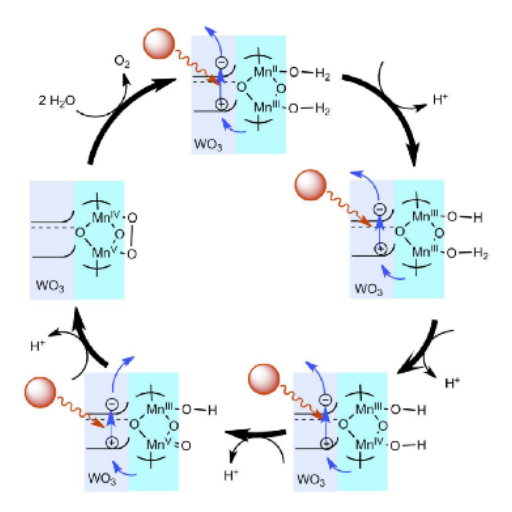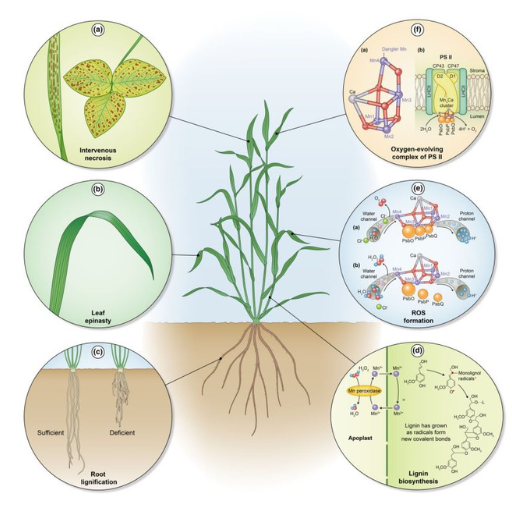Manganese (Mn) plays a crucial role in the growth and development of plants, acting as an essential micronutrient that supports various physiological processes. As an integral component of several enzymes, manganese is vital for photosynthesis, where it aids in the water-splitting reaction necessary for the formation of oxygen. Additionally, it is instrumental in nitrogen metabolism, influencing the synthesis of amino acids and the plant’s overall health. Understanding the functions and benefits of manganese highlights its significance in plant biology and emphasizes the importance of proper nutrient management in agricultural practices to ensure optimal crop yields. In this blog post, we will explore how manganese supports plant life and discuss strategies for effective manganese management in various cultivation scenarios.
What is Nitrogen Metabolism, and Why is it Important?

The Understanding of Nitrogen Metabolism in Plants
Nitrogen metabolism is the class of biochemical activities that refers to how nitrogen is taken up and assimilated into plants and the kinds of substances and concepts that nucleotides or, more importantly, amino acids are, which the plant possesses. Therefore, for the normal development and growth of the individuals and the population of plants, a quantitative and qualitative supply of protein feed is essential. Generally, nitrate (Nitrate, NO3 −) and ammonium (NH42 +) nitrogen are taken from the ground in plants. When these nitrogen forms are taken up, they go through several reduction and assimilation processes to fill in the essential molecules. Appropriate nitrogen metabolism not only helps in the reshaping of the structure and in the development of metabolic requirements of the plant but also in enhancing and boosting the yield of crops, which explains the importance of effective nitrogen management in farming practices.
Essential Steps of Nitrogen Assimilation
Plant nitrogen assimilation involves three significant steps: nitrate reduction, ammonium incorporation, and amino acid synthesis. First, it is the nitrate (NO3-) obtained from the soil that gets reduced in the form of nitrite (NO2-) and further gets converted to ammonium (NH4+) by enzymatic activities of nitrate reductase and nitrite reductase. After the nitrogen is reduced to ammonium, it can readily enter organic molecules. This is where the enzyme glutamine synthetase is impacted with the ammonium being combined with glutamate to give glutamine which acts as a precursor in the production of other proteinogenic amino acids. Then, using the transamino-functionalized methods, these amino acids are found in protein and other important technologies and structures, which shows that it is important to absorb nitrogen efficiently for the health and productivity of the plant.
Effects of Nitrogen Deficiency to the Well-being of Plants
Plants that ‘suffer’ nitrogen deficiency are to experience a myriad of negative effects to the growth and health of the plant. One of the first signs is the change in color of the leaves to yellow, mostly older leaves, as chlorophyll is degraded and this retards photosynthesis. This may result to stunted growth, low yields and poor quality crops. Additionally, already small leaves and fewer branches as they kid comprehend the limited amounts of nitrogen. An advanced nitrogen deprivation could eventually influence plants to drop their leaves favoured growth and expose them to disease. Therefore, the adverse effects of nitrogen deprivation are addressed to enhance the plants’ growth.
How Does Photosynthesis Work in Relation to Nitrogen?
Linkage of Photosynthetic Carbon and Nitrogen Content in Plants
The dependence on nitrogen and carbon content in plants along with their photosynthetic rate remains to be the concern of the plant overall physiology. Nitrogen is an essential element for the synthesis of chlorophyll, proteins, enzymes, and nucleic acids – all of which contribute to the process of photosynthesis. The presence of nitrogen is also known to increase the quantity of chlorophyll. This allows better absorption of light energy and in turn results in higher photosynthesis and carbon fixation. However over just these nutrients, nitrogen if in low quantity can hinder the ability of plants to perform photosynthesis since lesser chlorophyll content means lesser energy derived hence little carbon assimilated. If such interdependence is maintained, the management of the nutrients should be balanced so that there is maximum plant growth and productivity while ensuring the health of the plants.
Role of Nitrogen in Improving Carbon Metabolism
Nitrogen is one of the most significant factors in carbon metabolism by plants since it aids multiple biochemical reactions. First and foremost, it participates in amino acid synthesis, whose derivatives form proteins that are enzymes of the metabolic process including carbon fixases. Provision of adequate nitrogen nutrition favors the production of rubisco, which is an enzyme that incorporates CO2 from the atmosphere into the photosynthetic pathway. Furthermore, nitrogen is involved in forming nucleotides and nucleic acids that are core to ATP synthesis, the energy substrate of cells. This energy is employed in numerous metabolic activities, such as transforming carbon metabolites during respiration and forming organic substances. Therefore, for optimum carbon metabolism, nitrogen retention in plant tissues is essential, enhancing plant growth and productivity.
Nutrient Dependence and Photosynthesis: The ‘N’ in carbon assimilation
The availability of nitrogen forms adversely affects the photosynthetic performance of plants. Nitrogen in the appropriate amounts fosters chlorophyll formation, enabling more light to be absorbed for increased rates of photosynthesis. Given the sufficiency of nitrogen, the rates of carbon dioxide uptake by the plants are significantly high, and therefore, the general productivity and growth are enhanced. On the other hand, a nitrogen deficiency can lead to incomplete chlorophyll biosynthesis, stunted growth, and reduced photosynthetic ability as plants become less efficient in light harvesting and energy conversion. Nutrient in this circumstance is fundamental, as nitrogen is indispensable to the processes if healthy and sufficiently productive plant systems are to be sustained.
What are the Key Components of Carbon and Nitrogen Metabolism?

Understanding how C and N Metabolism Interactions work
Carbon (C) and nitrogen (N) metabolism in plants these two processes are interlocked in a manner that assists in the energetic and developmental aspects of the plant. Carbon metabolism constitutes the assimilation of atmospheric CO2 through photosynthesis which eventually results into the synthesis of carbohydrates which will be utilized as energy sources for plants. The processes are however well complemented by the metabolism of nitrogen in that it provides amino acids, proteins, and nucleotides which are crucial for cell functioning and growth.
For instance, the development of amino acids from carbohydrates is dependent on the availability of nitrogen and the carbohydrates are provided by the C skeletons. Further, C Units are also essential for N incorporation by forming nucleotides and other related compounds from photosynthetic precursors. Each of the parties possesses their limitations at their extremes. Excess nitrogen will promote the deposition of carbon skeletons, on deficient nitrogen, it will not be possible to produce such a pertinent element, in this case, carbon for creating organic forms. Such interactions have illustrated the role of nitrogen and carbon in preserving the state of plant metabolism necessary for its active growth and development.
Metabolic Pathways Involved in Nitrogen Assimilation
Plants utilize two predominant pathways to assimilate nitrogen: the ammonium assimilation pathway and the nitrate assimilation pathway. Within the ammonium assimilation pathway, glutamate dehydrogenase condenses ammonia and α-ketoglutarate to produce glutamate, an intermediate used in the formation of various amino acids. Alternatively, the nitrate assimilation pathway involves the reduction of nitrate NO3− into nitrite NO2−, a process where the enzyme nitrate reductase is engaged. Then reduction to ammonium by nitrite reductase is conducted. The formed ammonium is then incorporated into organic compounds through the same incorporation processes employed during ammonium assimilation. These pathways are essential steps in the process of incorporating inorganic nitrogen in organic molecules. This in turn increases the levels of amino acids required to produce proteins that are vital for plants. The effectiveness and regulation of these pathways are crucial for the optimum consumption of nitrogen and the welfare of the plants in general.
How Does Soil Nitrogen Affect Plant Growth?

Types of Nitrogen Fertilizers and Their Effects
Nitrogen fertilizers are categorized into the following three main types : ammonium-based, nitrate-based, and organic fertilizers.
- Ammonium-Based Fertilizers: These involve the use of ammonium sulfate and urea. These are readily utilized by plants and may modify the soil’s pH to a more acidic condition. Despite their benefits, a quick release might bring about potential nitrogen leaching of blue-green algae if not properly controlled.
- Nitrate-Based Fertilizers: These include a group of fertilizers containing ingredients like calcium nitrate and sodium nitrate. The nitrate form present is readily available to crops for immediate utilization, making it suitable for use in short-term plantation crops. However, their easy availability makes it quite possible for them to be leached off into water bodies, which is not a good environmental practice.
- Organic Fertilizers: These include compost and manure, where nitrogen is provided mainly in the size of ammonium, which is released during the biological activities of nitrogen immobilization. These materials maintain good soil structure and high activity of soil organisms, but provide nutrients at much lower concentrations than chemical fertilizers. Since there is more time for nitrogen to be cut down, nitrogen deficit from crops can also be avoided and a steady supply of feed can be maintained.
Each nitrogen fertilizer stimulates plant growth and nutrient availability, as well as having other environmental impacts, and hence, it’s necessary to comprehend it within the agronomic practice.
Impact of Soil Nitrogen on Plant Nutrition
Soil nitrogen is significant to plant metabolism since it supplies the amino acids, proteins, and nucleic acids needed for plant growth and development. When nitrogen is abundant on the earth, plants construct more efficiently protein, which increases the number of plants and crop productivity. Also, nitrogen facilitates the production and accumulation of chlorophyll, which is needed for photosynthesis. This means that sufficient soil nitrogen not only aids in healthy growth of the plants, but also improves photosynthesis in that more solar energy is captured and converted into a usable form by the plants. An instance of the impact of nitrogen deficiency is when crops do not develop fully or have stunted lagoons and lower amounts of chlorophyll and subsequent harvests are reduced.Change in the environment would even mean lower zones for the crops. There is therefore the need to ensure adequate nitrogen levels are in place for agricultural systems.
Ways of Enhancing Nitrogen Utilization Efficiency
Nitrogen use efficiency (NUE) optimization is a very important factor whose practice will benefit crop yield without and negative effect on the ecosystem. Some of the most common strategies will be presented below:
- Regularly Conducting Soil Tests: Analysis of the soil is necessary because it reveals the nitrogen that is already present in the soil and assists to formulate the usage of fertilizer to avoid instances of applying too much or too little if ever farmers adopt the right strategy of using it at that material time.
- Geo-targeted Nutrient Management: Since technologies such as GPS and remote sensing are available, nitrogen fertilizers can be applied in ways that are economically friendly and better received by crops.
- Cover Cropping: In addition to nitrogen fixation, cover crops improve soil quality and add nitrogen content. They also reduce nutrient leaching in the off-season.
- Enables Split Applications of Fertilizers: Although quick-release fertilizers must be provided in the crop root zone, too many or one-shot applications carry risks like leaching.
- Use of Enhanced-Efficiency Fertilizers: These fertilizers are optimally engineered for delayed nitrogen release or retardation of nitrogen loss mechanisms, thus increasing NUE.
By incorporating all these techniques, agricultural practices can greatly improve the utilization of nitrogen, which will result in better profitability and less harm to the environment.
What is the Relationship Between Nitrogen Supply and Photosynthesis?

Photosynthesis Responses to Varying Nitrogen Resupply Rates
While studying the concept of photosynthesis in relation to nitrogen referral, I have observed that nitrogen arguably is one of the primary macronutrients essential to the agro-horticultural physiology. With a nitrogen balance tipping positively, the photosynthetic rates rise with an increase in biomass and better crop outputs. Conversely, inadequate nitrogen can negatively affect chlorophyll production, limiting the plant’s ability to collect light energy from its environment. Similarly, too much of nitrogen becomes the limiting factor on the growth of plants not because of its deficiency, but because the uptake strategy has been uncoordinated. I can say that vegetative growth can be improved by optimizing nitrogen levels towards achieving the maximum photosynthesis required for good crop productivity.
Nitrogen Stress Effects on Photosynthetic Rates Animps
Photosynthesis had been reduced quite significantly in plants during nitrogen stress as recorded by me. Under such stress, chlorophyll molecules are not synthesized, thus the efficiency of light energy catching converting into chemical energy is limited. This deficiency not only causes a decrease in the growth rate of the plant above the ground but also needs relaxing of the tissues around the apical meristem of the developing leaves. Therefore such plants tend to have poor growth and goldish green leaves, known as chlorotic plants. Besides, the deficiency of nitrogen also leads to the reduced amounts of the key enzymes that catalyze the processes of photosynthesis such as carbon fixation. Therefore, it is imperative to consider the optimal use of nitrogen levels for optimum plant development and enhancement of the photosynthesis process.
Reference sources
- Physiological functions of manganese in plants – This article discusses the impact of manganese deficiency on soluble nitrogen levels and its relation to photosynthesis.
- The biochemistry of manganese in plants – This paper explores the biochemical processes involving manganese in plants, highlighting its role in photosynthesis.
- Manganese nanoparticles: impact on non-nodulated plant as a potent enhancer in nitrogen metabolism and toxicity study both in vivo and in vitro – This study examines the use of manganese nanoparticles in enhancing nitrogen metabolism and their effect on photosynthesis.
These sources should help validate the feasibility of manganese’s role in supporting photosynthesis and nitrogen metabolism in plants.
Frequently Asked Questions (FAQs)

Q: Has manganese deficiency any effect on the nitrogen uptake of the plant tissues?
A: Yes, deficient levels of manganese tend to alter nitrogen use efficiency. In instances where manganese is in short supply, the uptake of nitrogen by the plants may not be optimal, which affects their growth and response to nitrogen fertilization.
Q: What’s the contribution of manganese to the metabolism of sugars in vegetative cells?
A: Manganese also contributes to the degenerative plastic process by helping carbohydrates be transformed to form energy. This process is associated with the metabolism of nitrogen, for nitrogen is needed to make amino acids and proteins, and proteins and amino acids are essential in the metabolism of the plant.
Q: How does manganese act on the stress response mandating nitrogen limitation in plants?
A: Manganese is an element of significance to plant signaling during stress responses, especially when nitrogen is limited. It assists in activating these stress responses, enabling the plant to cope in a low-nitrogen environment and thus enhancing survival.
Q: How do manganese levels in plants respond to additional nitrogen application?
A: Nitrogen fosters the plants’ absorption of manganese, thus resulting in better nitrogen nutrition and improved plant health. Yet, the proportions of the supplementing nutrients should be taken into consideration, as supplementary nitrogen can restrict manganese absorption.
Q: What is manganese’s function regarding nitrate assimilation in higher plants?
A: Nitrate assimilation is one of the processes that take in most metabolites required for plant growth, and such processes are catalyzed by several enzymes, for which manganese is an essential cofactor. Appropriate levels of this element, therefore, allow plants able to utilize nitrates more efficiently by making sure that these compounds enter natural cycles in forms that are usable by the plants.
Q: How do the transgenic tobacco plants exemplify the role of manganese in nitrogen and carbon metabolism?
A: Manganese-overseeing transgenic tobacco plants are shown to have improved carbon and nitrogen metabolism due to photosynthetic induction. Such activities and other related strategic approaches result in the increasing of the rate of growth and the improvement of the conditions of stress, indicating that manganese is vital for primary metabolism.






